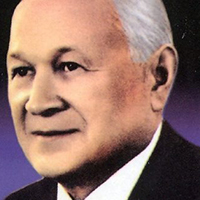Vladimir Chelomey
Vladimir Nikolayevich Chelomey or Chelomei was a Soviet mechanics scientist, aviation and missile engineer. He invented the first Soviet pulse jet engine and was responsible for the development of the world’s first anti-ship cruise missiles and ICBM complexes like the UR-100, UR-200, UR-500 and UR-700.
From the beginning of the Great Patriotic War in 1941, Chelomey worked at the Baranov Central Institute of Aviation Motor Building (TsIAM) in Moscow, where he created the first Soviet pulsating air jet engine in 1942, independently of similar contemporary developments in Nazi Germany.
Chelomey was born in Siedlce, Lublin Governorate, Russian Empire (now Poland). At the age of three months, his family fled to Poltava, Ukraine, when the Eastern Front of World War I came close to Siedlce. When Vladimir was twelve years old, the family moved again to Kiev. In 1932, Chelomey was admitted to the Kiev Polytechnic Institute where he showed himself as a student with outstanding talent. In 1936, his first book Vector Analysis was published. Studying at the institute, Chelomey also attended lectures on mathematical analysis, theory of differential equations, mathematical physics, theory of elasticity and mechanics in the Kiev University. During this time Chelomey got interested in mechanics and in the theory of oscillations and remained interested the rest of his life. In 1937, Chelomey graduated from the institute with honours. After that he worked there as a lecturer, defending a dissertation for the Candidate of Science (in 1939).
From the beginning of the Great Patriotic War in 1941, Chelomey worked at the Baranov Central Institute of Aviation Motor Building (TsIAM) in Moscow, where he created the first Soviet pulsating air jet engine in 1942, independently of similar contemporary developments in Nazi Germany. After an early career in 1944–53 designing copies of the German V-1 “buzz bomb,” Chelomey formed a new design bureau known as OKB-52, in Reutov, outside of Moscow, in 1955. There he began working on a series of advanced naval cruise missiles. In 1959 he initiated development of new rockets and spacecraft for the emerging Soviet space program.
Chelomey oversaw a huge empire by the mid-1960s, working on several intercontinental ballistic missiles (ICBMs), military satellites, launch vehicles, cruise missiles, and antiballistic missiles.
After Khrushchev’s ouster in 1964, despite falling out of favour, Chelomey produced the UR-100 ICBM (known in the West as the SS-10), the Proton launch vehicle, the Almaz military space station (launched as Salyut 2, 3, and 5), and the Transport-Supply Ship (TKS), which was designed as the resupply vehicle for Almaz.
He was twice awarded the Hero of Socialist Labour (1959, 1963), the highest award given to civilians during the Soviet era. Many of Chelomey’s creations, such as the Almaz, Proton, and TKS, continue to serve the current Russian space program in updated form.

Vladimir Chelomey
Date of Birth: 30 Jun 1914
Birth Place: Siedlce, Poland
Proffession: Soviet scientist
Nationality: Poland
Death: 12 August 1984, Moscow, Russia


